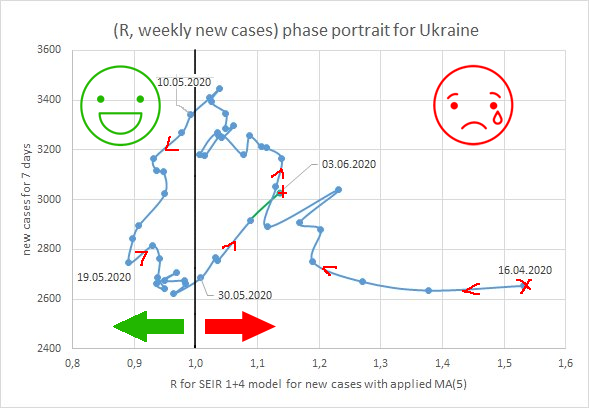Ukraine is slowly getting back to normal and lifting its quarantine restrictions, but the COVID-19 epidemic in the country is far from subdued.
A record number of 588 new COVID-19 cases was registered in the country on 3 June, according to statistics published by the Ministry of Health. This is the largest number of new daily cases since the outset of the epidemic in Ukraine. See how in this excerpt from our live page Interactive COVID-19: Ukraine and world:
var divElement = document.getElementById(‘viz1591313837022’); var vizElement = divElement.getElementsByTagName(‘object’)[0]; if ( divElement.offsetWidth > 800 ) { vizElement.style.width=’100%’;vizElement.style.height=(divElement.offsetWidth*0.75)+’px’;} else if ( divElement.offsetWidth > 500 ) { vizElement.style.width=’100%’;vizElement.style.height=(divElement.offsetWidth*0.75)+’px’;} else { vizElement.style.width=’100%’;vizElement.style.height=(divElement.offsetWidth*1.77)+’px’;} var scriptElement = document.createElement(‘script’); scriptElement.src = ‘https://public.tableau.com/javascripts/api/viz_v1.js’; vizElement.parentNode.insertBefore(scriptElement, vizElement);
The number of recoveries was also the largest on 3 June – 602. Taken together, although the number of recoveries and new infections has lately been roughly equal, there are still more infections and the number of active cases (yellow on the graph below) has been rising incrementally in the last weeks:

This trend is alarming because Ukraine is slowly lifting its COVID-19 lockdown measures. The country reacted swiftly, imposing a strict lockdown before there was a large COVID-19 outbreak and has thus far managed to evade the staggering death tolls of Western Europe. Schools and public transport were closed in early March, as were restaurants and non-essential shops. This strict lockdown lasted for nearly two months until public resistance started growing and on May 22 Ukraine relaunched public transport and started gradually opening up venues. Notably, restaurants with inside seating are to be reopened on 5 June.
Despite the quarantine being phased out, COVID-19 isn’t. Ukraine’s Ministry of Health says that more and more oblasts are not ready to ease the lockdown.
On 4 June, Ukraine’s Ministry of Health stated that 9 regions – Volynska, Dnipropetrovska, Donetska, Zhytomyrska, Luhanska, Lvivska, Rivnenska, Chernivetska oblasts and the capital Kyiv – are not ready to soften the lockdown (marked with a red X below), while on 1 June the number was only 6:

Offering further pessimism is a graph of the reproduction number of COVID-19 in Ukraine, or simply R. It is a way of rating a disease’s ability to spread. It’s the number of people that one infected person will pass the virus on to, on average.
Some diseases, like measles, spread very quickly – it has a reproduction number of 15 in populations without immunity. The new coronavirus, known officially as Sars-CoV-2, has a reproduction number of about three, but estimates vary.
This is why nations have imposed lockdowns around the world: to lower the R so that eventually the outbreak of disease subsides.
Dr. Ihor Ivanov, a researcher at the Institute of Mechanics of the National Academy of Sciences of Ukraine, has been modeling reproduction numbers for COVID-19 in Ukraine. His results are in the graph below.
On the Y-axis is the sum of new COVID-19 cases in the last 7 days. On the X-axis is the R number calculated by Dr. Ivanov. On 16 April, the R number was the highest: one person infected more than 1.5 people, on average. Then R gradually lowered, until it passed the threshold of 1 (the thick black vertical line) on 10 May, when 3350 new people were contracting COVID-19 per week, meaning that one person infected fewer than one other person, on average.
After that, we see both the number of infected people and R falling until 19 May, after which the trend is reversed – both R and the number of new infected people rises, until on 30 May R is again over 1, meaning that one infected person will pass on the disease to more than one other person and the outbreak of disease grows.
Did the quarantine which started to be relaxed on 12 May have something to do with this? It may very well be – as the number of newly infected people will be registered on tests with a lag of around a week.

This means that, unfortunately, Ukraine will need to make the difficult choice of either prolonging the lockdown at the cost of the economy or prepare for many more deaths over the summer. It failed to suppress the outbreak in the two months of lockdown and is thus will be forced to face the problem while its population has become weary of following lockdown limitations.
See more graphs at our live page Interactive COVID-19: Ukraine and world:










